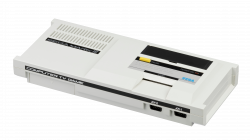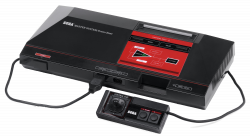Master System:Master System Model Differences
Page content & researching partially taken from io55.net's Sega Master System page with permission, in collaboration.
There are fpur Master System models.
Models
Models are arranged chronologically.
Mark III (1985-1987)
This is the original release of the Master System hardware, released in Japan on October 20, 1985. The Mark III cosmetically resembles its predecessor, the SG-1000 II, and is roughly the same size as that earlier console. Located on the left-hand side is an expansion port carried over from the SG-1000 line, used to connect the SK-1100 keyboard and the later FM Sound Unit (note that this expansion port is not the same used on later international consoles). Two controller ports are located on the right-hand side (which are numbered in opposite order compared to other consoles) as well as a built-in card slot for reading games on the Sega Card/MyCard format. On the back are the power switch, RF out and AV out. The Mark III is also backwards compatible with SG-1000 games, but the color palette is vastly different compared to an original SG-1000 console and may make playing certain games difficult.
The Mark III was also the first Sega console to possess RGB output, but it is unamplified and requires external circuitry or modification to make it suitable for most displays. Sega did not sell an official RGB cable in Japan or even acknowledge the fact that it featured RGB output.
Master System (1986-1991)
The original release of the Master System hardware for the rest of the world. Although largely internally identical to the Mark III, the Master System is vastly different cosmetically, featuring a black and red color scheme, and is larger than the Mark III. Located on the front are the power switch, controller ports and Sega Card slot. The international Master System also has amplified RGB output and a different expansion port, which never saw use. Sega also changed the cartridge port and shape for the West, so Japanese cartridges and SG-1000 games are not compatible.
Earlier revisions of the console only have a secret Snail Maze game built-in. Beginning in late 1987/early 1988, Sega began including Hang-On or Hang-On/Safari Hunt as a built-in game for most bundles, with the SegaScope 3D bundle including a console with Missile Defense 3-D built-in. Very late original European models also have Alex Kidd in Miracle World built-in.
Master System (MK-2000, Japan) (1987-1988)
For the Japanese market in late 1987, Sega replaced the Mark III with a revised version of the international Master System with extra hardware features. It very closely resembles its non-Japanese counterpart, but does have some crucial differences. The FM Sound Unit, 3-D glasses adapter and Rapid Fire Unit are all built-in to this console, adding extra value; these were all optional accessories for the Mark III. It still uses the same cartridges as the Mark III and is also backwards compatible with SG-1000 games. This console also has a very distinctive BIOS which plays a rendition of the Space Harrier theme (using both FM and PSG sound) when no game is inserted.
This model was also the basis for the Samsung Gam-Boy, released in South Korea in 1989.
Master System II (1990-1993)
A cost-conserving slimmed down version of the Master System, released in 1990 in North America and 1991 for PAL regions. Noticeably smaller than the original, this version lacks the card slot (meaning no 3-D glasses support), expansion port, composite out, and reset button (French Master System IIs still possess RGB output, albeit unamplified). The cartridge port is also hidden behind a clear plastic sliding door displaying the console name. Most PAL models feature an all-black color scheme while all NTSC and some Australian and French consoles have a light gray top half with a white pause button.
Most SMS IIs have Alex Kidd in Miracle World built-in (including all NTSC consoles) while later PAL models have Sonic the Hedgehog built-in.
References
https://en.wikipedia.org/wiki/Master_System
https://en-academic.com/dic.nsf/enwiki/5908108
https://gametrog.com/sega-master-system-information-specs/
https://segaretro.org/Master_System_consoles_in_North_America
https://gametrog.com/sega-powerbase-converter-information-specs/


